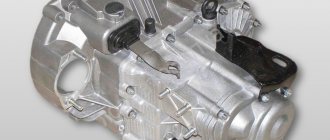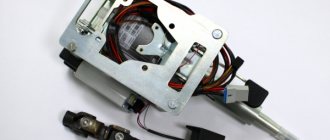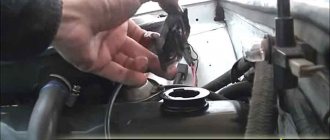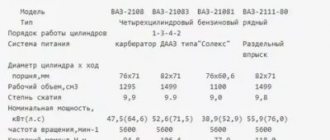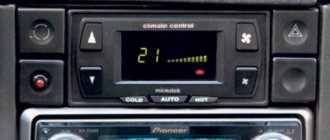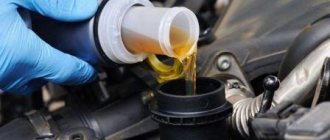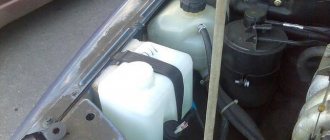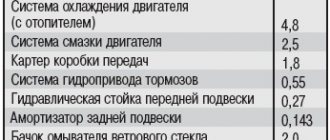Powertrain Maintenance
The frequency of maintenance of the Priora engine by the manufacturer is 15 thousand km. It is recommended to carry out the first maintenance after 3 thousand km. The main attention should be paid to checking all attachment points for attachments. During this same service, the first oil and oil filter change is carried out. If the engine is 8-valve, it is worth checking the valve clearances. For a 16-valve engine, this measure is not necessary, since hydraulic compensators are installed on this power unit. Similar work is carried out after 15 thousand kilometers of the Priora.
After the odometer reaches a value of 30 thousand km, in addition to changing the oil and oil filter, the spark plugs and power system filters require replacement. Often, at this mileage value, the timing tension pulley gradually begins to fail. If the Priora has an 8-valve engine, it will not be superfluous to replace the valve cover gasket.
What happened during all this time?
I’ll probably start with those units that remained practically untouched, and then at the end I’ll tell you the most interesting, as they say, for the road!
Body – has it stood the test of time?
As everyone knows, the doors and fenders of a car are the weakest point in the Priora’s body. I cannot say that it rotted quickly, although there are cases when in a couple of years the cars were already very rusty. Literally after 5 years of operation, saffron milk caps began to appear on the bottoms of the doors, the hood and trunk lid were covered with bugs after 6 years of ownership.
The bottom is still intact, but ideally it would be desirable to paint the entire car, since there are essentially no living parts left.
Interior and finishing inside
Frankly, the original Prior seats that were produced before 2011 were much stronger than what is being made now. After 500,000 km, I replaced the seats, since they were already dented, but today’s Priors are unlikely to boast such seats with such wear resistance.
The photo above shows a set that has actually covered half a million kilometers. As you can see, the condition is certainly not 5 plus, but in current versions they become like this already after 150-170 thousand km.
The interior plastic of older cars was stronger, scratched less, and you didn’t have to bother with cleaning, etc. The casing is of course worn out during this time, but still alive:
Engine and gearbox
Well, now the most interesting thing is that you will definitely like it! It would be naive to believe that over such a long mileage the gearbox will run without problems and, most importantly, without repairs. It’s the same with this car, after 250 thousand a used gearbox was purchased, since the factory one had died. Then, again after 150 thousand, the gearbox was repaired with the replacement of some gears and synchronizers with clutches. And recently I bought another box, and again a used version, since a new one costs an incredible amount of money. As a result, 2 used ones and one repair is the expense that will happen in 700 t.km.
How much does engine 126 and 127 cost?
Engine 126 has catalog number 21126100026030, sells for about 107,000 rubles, engine 127, respectively, has catalog number 21127100026030, its price is slightly higher by 3-5 thousand rubles. The price on the secondary market will be significantly lower (up to 20-25 thousand rubles), but the savings will not pay off - a used “engine” can last no more than 1000 km, this is a real lottery.
How to find out what engine is in a Priora
You can find out by looking at the plate on the left glass of the rack, where the engine number is written on the edge. From it you can understand the 8-valve unit, or 16. You can also recognize the modification 21126 or 21127.
Engine tuning Priora 21126 1.6 16V
Chip tuning of the Priora engine
For fun, you can play with the sports firmware, but there will be no obvious improvement; see how to properly increase the power below.
Priora engine tuning for the city
There are legends that the Priora’s engine produces 105, 110 and even 120 hp, and the power was underestimated to reduce taxes, various measurements were even taken in which the car produced similar power... what everyone decides to believe, let’s focus on the indicators declared by the manufacturer. So, how to increase the power of a Priora engine, how to charge it without resorting to anything special, for a small increase you need to let the engine breathe freely. We install a receiver, a 4-2-1 exhaust, a 54-56 mm throttle body, and we get about 120 hp, which is quite good for the city. Boosting the Priora engine will not be complete without sports camshafts, for example, STI-3 camshafts with the configuration described above will provide about 140 hp. and it will be fast, an excellent city motor. The refinement of the Priora engine goes further, sawn cylinder head, Stolnikov 9.15 316 shafts, light valves, 440cc injectors and your car easily produces more than 150-160 hp.
Compressor for Priora
An alternative method of obtaining such power is to install a compressor, for example, the most popular option is an Auto Turbo kit based on PK-23-1, this compressor is easily installed on a 16-valve Priora engine, but with a lower compression ratio. Then there are 3 options: 1. The most popular, lower the coolant gasket with a gasket from a twelve-wheeler, install this compressor, exhaust on 51 pipes, Bosch 107 injectors, install it and go to the track to watch the car go down. But the car doesn’t run very well... then running to sell the compressor, writing that the Autoturbo doesn’t work and all that... is not our option. 2. We lower the coolant by installing a thick cylinder head gasket from 2112, for a St. Petersburg supercharger at a pressure of 0.5 bar this will be enough, we select the optimal narrow-phase shafts (Nuzhdin 8.8 or similar), 51 exhaust pipes, Volga BOSCH 107 injectors, a receiver and a standard throttle body. To fully push the configuration, we give the cylinder head to cut the channels, install larger lightweight valves, this is not expensive and will provide additional power throughout the entire range. This whole thing needs to be configured online! We’ll get an excellent motor with a power of more than 150-160 hp that can perform in any (!) range. 3. We lower the coolant by replacing the piston with a tuning one for the turbo, you can put a proven Nivov piston with a puddle under the turbo on 2110 connecting rods, on such a config you can put a more efficient compressor, a Mercedes one for example, blowing 1-1.5 bar with a power of well over 200+ liters .With. and act like the devil! ) The advantage of the config is the ability to install a turbine on it in the future and blow out at least all 300+ hp. if the piston doesn't go to hell))
Technical characteristics of Lada Priora engines
Home > Tuning
The release of the new VAZ 2170 Lada Priora model in 2007 is rightfully considered an undoubted achievement of the domestic automobile industry. The new car is able to compete on equal terms in its technical and operational characteristics with imported analogues of the same class and is a very attractive option in its price category.
Lada Priora engine review
Return to contents
General characteristics
Initially, the car was equipped with an 8-valve engine from the VAZ 2114, about which car enthusiasts in practice know all the characteristics, in particular, what kind of service life it has in different modes. Therefore, the first “Priors” did not receive rave reviews from customers.
Subsequently, the car was equipped with its own 16-valve unit modification 21126 with a displacement of 1.6 liters and a power of 98 horsepower, which made the VAZ 2170 truly competitive. Dynamic performance has been improved, emissions into the environment and fuel consumption have been reduced. Relatively recently, an updated version of the 21127 engine with a power of 106 hp appeared. which has been installed on Priora since 2013. Comparative characteristics of all three units are given in Table 1.
Table 1
| Specifications | Engine VAZ 2114 | Engine VAZ 21126 | Engine VAZ 21127 |
| Year of issue | 1994 | 2007 | 2013 |
| Cylinder block material | Cast iron | Cast iron | Cast iron |
| Type/number of cylinders | Inline/4 | Inline/4 | Inline/4 |
| Number of valves | 8 | 16 | 16 |
| Piston stroke, mm | 71 | 75,6 | 75,6 |
| Cylinder diameter, mm | 82 | 82 | 82 |
| Compression ratio | 9,8 | 11 | 11 |
| Working volume, cm³ | 1499 | 1597 | 1596 |
| Unit power, hp | 78 at 5400 rpm | 98 at 5600 rpm | 106 at 5800 rpm |
| Torque, Nm | 116 at 3000 rpm | 145 at 4000 rpm | 148 at 4000 rpm |
| Fuel consumption |
highway/city/mixed,
l/100 km
Return to contents
Updates and shortcomings
The table clearly shows how many horses the Priora had with the old power plant and how the power and torque changed as the update progressed. Here is a description of how the design features of the new units changed compared to the old ones:
- The number of valves has increased, there are 4 of them for each cylinder. It's no secret what a positive impact this factor has on engine performance. The filling of the cylinder with the combustible mixture improves, the chamber is qualitatively emptied of combustion products (exhaust gases), the operation of the unit becomes more stable, power increases while fuel consumption decreases.
- The compression ratio is increased by increasing the piston stroke. The new engine 21126 and 21127 now uses gasoline with a higher octane number, but at the same time the efficiency of fuel combustion increases, which has a positive effect on power. It’s impossible not to notice how the working volume of the Priora’s engine has increased thanks to the increased piston stroke.
- In modification 21127, compared to 21126, the intake manifold was modified. How this affected the engine performance of the Priora can be seen in the table. Power increased by 8 hp. in addition, performance at low and medium speeds has improved.
- The new engines on the Priora have better environmental performance and lower fuel consumption. This was achieved through such improvements as modernizing the crankcase ventilation system and reducing the weight of the piston group. Now crankcase gases are burned more intensively in the cylinders and the emission of harmful substances into the atmosphere has decreased.
- Over the many years of operation of VAZ vehicles, a definite opinion has developed that the power units of Zhiguli cars do not last 150 thousand km until they are overhauled. Now, due to the use of new, higher quality components, the engine life has increased to at least 200 thousand km.
Despite the fact that the updated Priora engine is almost the most advanced domestic unit, it has its drawbacks. For example, when a timing belt breaks, the valves inevitably collide with the pistons and bend - this is its most serious drawback. How to eliminate it without waiting for trouble? It is necessary to replace the standard pistons with new ones, with special selections for the valves.
The remaining shortcomings are not so significant and they are usually associated with some kind of defect that can still be found on domestic cars. This could be increased noise from the operation of hydraulic compensators (often found on VAZ cars), an unexpectedly burnt gasket under the cylinder head, or floating idle speed. Or some unit of the attached equipment fails:
- a drop in fuel pressure in the system leads to difficulty starting the Priora engine and loss of its power;
- sensor malfunctions;
- air leaks in the fuel tract through the pipes;
- problems with the injector throttle valve.
Return to contents
Recommendations for improvement
For the first time, they decided to increase the power of the new Priora 21126 engine at the factory in order to create a sports modification of it. Camshafts with increased lift, a lightweight connecting rod and piston group were installed, and the intake and exhaust tracts were modified. This is how the first domestic sports unit appeared, which was put into production, and they began to install it on the Lada Granta Sport model.
The technical characteristics of the engine are as follows: engine power from the Priora has increased to 118 hp. torque - up to 154 Nm at 4700 rpm, fuel consumption also increased to 7.8 liters per 100 km with a combined driving cycle. We will give a number of recommendations on how to independently increase the power of Priora engines:
- The simplest and most affordable way is to install a zero-resistance exhaust tract. The essence of its work is to reduce the resistance of the path, as a result of which some of the power spent on overcoming this resistance will be released and become useful.
- The same operating principle applies to the zero-resistance intake tract. Installing the receiver and throttle valve to 56 mm will allow the power unit to “breathe” more freely, and your Lada Priora will become several horsepower more powerful.
- Deeper tuning - new camshafts with a sports configuration, allowing the intake and exhaust valves to open more. This will give a noticeable increase in the agility of the car, especially in city conditions.
- Replacing the standard valves and connecting rod-piston group with a lightweight one will again release some of the useful energy of the unit and add it to the main power. Here you can kill two birds with one stone: install pistons with recesses, thereby eliminating the possibility of them “meeting” with the valves when the timing belt breaks.
- We should not forget about CHIP tuning. After major changes in the engine configuration, its operating mode will definitely improve, and in order to optimize it and adjust fuel consumption, you need to do a flashing.
Recommendations are given taking into account that the power plant is in good technical condition. If this is not the case, when tuning it is worth replacing worn parts and oil in order to get the desired effect from the changes. As a result of the above measures, the Lada Priora will receive an additional 20-30 hp. without reducing the resource.
How many horses can Priora have in addition to this? Quite a lot, there are capabilities and components to increase the power ultimately to 400 hp. This is due to a radical modification of the power plant: boring the cylinders, grinding the cylinder head, replacing the injectors and fuel pump with more efficient ones, installing four throttle valves and a turbocharger.
We should not forget about modernizing the brake system. Such tuning will give excellent results in terms of power, but the engine life will be significantly reduced, and fuel consumption, on the contrary, will increase significantly.
Return to contents
Rules for long-term use
Surely every Priora owner wants to operate his car without unnecessary unexpected costs and is thinking about how to increase the life of the car. To do this you need to follow a few simple rules:
- The power unit of the VAZ 2170, even without various improvements, has sufficient potential for “spirited” driving. But in order to save it and extend its life, such driving should be avoided. Smooth acceleration and maintaining a stable speed not only on the highway, but also in the city will help extend the life of the engine and save fuel and your own money. The maximum permissible speed on the highway should be no higher than 120 km/h, the optimal is 100-110 km/h, and it is important to maintain stability.
- It is important to timely replace consumables, that is, oils in units, filters, spark plugs, high voltage wires, generator and timing belts, and coolant. The interval between engine oil changes depends on its quality and chemical base. Mineral-based oils should be changed more often, synthetic oils less often. You should never determine the quality of motor oil by its color. If it has acquired a black tint, this does not mean that the oil is bad - it means that an excessive amount of combustion product deposits is forming in the engine. First of all, you need to find the source of the carbon deposits and eliminate it, and then change the oil.
- The new engine must be properly broken in, and then the oil must be changed, following the manufacturer's instructions. When running in, avoid increased loads, sudden movements of the accelerator pedal, and do not exceed the speed specified in the instructions.
- Always monitor the engine coolant temperature, check the operation of the electric cooling fan, thermostat and temperature sensor. Overheating is the main enemy of the piston group; every time the temperature is exceeded, it wears out intensely, and the life of the unit is sharply reduced.
"Lada Priora" is a modern high-speed domestic car that will bring its owner a lot of positive impressions and driving pleasure, provided that the engine is cared for and properly modified and operated.
List of car models in which it was installed
Engines from VAZ on Priora were installed on the following modifications of cars of the domestic manufacturer:
- Lada Priora Hatchback restyling from 2013, three-door;
- Lada Priora Hatchback restyling from 2013, five-door;
- Lada Priora Station Wagon;
- Priora Hatchback restyling from 2010;
- Priora Station Wagon 2008;
- Priora sedan 2007.
Despite many positive reviews about the modified VAZ engines, they have drawbacks. We'll look at which ones in the next block. We will only touch on engine 21126.
Unqualified maintenance
Insufficient quality of air purification, or, even worse, a break in the air filter curtain will reduce the service life of the motor significantly. A heavily clogged filter will not let dirt through, but neither will air. The motor will operate in an off-design mode, and this will not extend its life.
It is important to follow the replacement intervals prescribed in the instructions. More frequent replacement is needed only in steppes and semi-deserts with their eternal dust. I advise you not to buy the cheapest filters - they can let large particles through. A good thing cannot be too cheap. It is best to buy filters from online spare parts stores.
What's the result?
As you can see, the service life of a VAZ engine directly depends not only on the quality of fuels and lubricants, but also on the operating characteristics of the vehicle, as well as on timely maintenance and necessary repairs.
The power unit should not be overloaded unnecessarily, jerking and other loads should be avoided. It is also important to remember that critical malfunctions (for example, engine overheating) can significantly reduce the planned life of the internal combustion engine.
In practice, compliance with these rules allows 150 thousand km instead of those declared by the plant. go 200-250 thousand without major repairs. Moreover, this approach allows you to reduce the cost of major repairs.
Simply put, careful operation in many cases means that after troubleshooting, a number of expensive parts may not require replacement, the complexity of restoration work is reduced, etc. The result is that repairing such an engine becomes less expensive.
Engine speed and service life. Disadvantages of driving at low and high speeds. At what engine speed is it best to drive? Tips and tricks.
How to determine when an engine needs a major overhaul: engine life, the main signs of an imminent overhaul. How to repair an internal combustion engine, tips
What is the normal engine service life for modern engines? Why are there no “millionaire” engines left? How to increase the resource of a modern internal combustion engine.
What does it mean to overhaul a car engine, what work is performed. What determines the engine life before overhaul and how to increase it. Useful tips.
Features of operation and maintenance of an internal combustion engine. What needs to be done to ensure that the engine runs as long as possible without a belt.
Why and how to run in a gasoline or diesel engine after a major overhaul. Driving modes, features of the break-in process, first oil change.
Signs of the need for internal combustion engine repair
The reasons why the operation of the engine is disrupted are arranged in a small list, starting with refusal to start and ending with floating idle speed (this problem was removed on the 127 “engine”). Not all breakdowns end in capital damage - sometimes it’s enough to add oil, sometimes it’s enough to adjust the ECU settings.
Compression reduction
A decrease in cylinder compression below 16 atmospheres is a bad sign. Such a high limit corresponds to a compression ratio of 11.
If the compression decreases (or vice versa increases), then the “engine” will have to be rebuilt.
Knocks in the engine
Engine knocks can come from several points. These could be hydraulic compressors, timing belt rollers or pins. The knocking noise could also be caused by low oil level. The answer to the question will be given by a thorough detailed inspection of all parts of the unit and checking the oil level.
Blue smoke from the exhaust pipe
The blue smoke that comes from the exhaust pipe appears when oil enters the combustion chamber. It can leak either from the valves or from under the piston. The result is the same: the oil is eaten up and blue smoke pours out of the chimney. Once the leak is located, half the problem will already be solved.
Troit motor
Sometimes in the cold the engine may stall - don’t be alarmed by this, because it may simply be one of the spark plugs that fails. In this case, we advise you to simply restart the engine and it will stop running.
How much does it cost to overhaul a Priora engine - average price
Self-repair of a Priora engine with 16 valves costs an average of 16-20 thousand rubles. The cost depends on the severity of the breakdown and may be lower or higher than this average range. Repairing a Priora engine can be entrusted to the wrong hands, but then you will have to pay for the work - sometimes the cost of repairs reaches as much as 40 thousand rubles.
This is an unreasonably inflated figure, because, as practice shows, you can rebuild the engine on a Priora, working at a moderate pace, in just three days - and three days of work is definitely not worth that kind of money. Don’t be afraid of not being able to cope - your Lada is easy to repair, and using the advice and “tutorials”, you will conquer even such a task that is impossible at first glance.
Engine operating temperature
We have learned the resource, now we move on to another important indicator. The optimal operating temperature is 90-95°C. After 97°C, engine number 126 with 16 valves will “slow down” a little, but according to the rules, temperatures up to 100°C are considered normal. If the Lada unit is operated with this indicator, then you need to be sure that the radiator fan is running at this time. When you see an indicator below +90°C on the dashboard, you need to assume that this is underheating. Of course, in cold weather the power plant needs more time for the temperature to reach normal levels.
Remember:
- Operating temperature – 90-95°C.
- Normal temperature (engine runs worse) is 97-110°C.
- Reduced temperature – 90°C and below.

